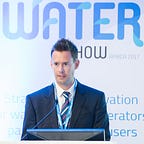Hong Kong’s Water-Energy-Climate Synergies
The Hong Kong Drainage Services Department (DSD) is actively implementing a range of renewable energy initiatives to mitigate climate change.
By 2040, the amount of energy used in the water sector is likely to double due to trends including increased desalination, large-scale water transfers, and increasing demand for wastewater treatment, as well as higher levels of treatment.
The energy used to supply water and clean used water is responsible for around 3–8% of global greenhouse gas emissions. With global demand for water projected to increase by 55% by 2050, a business-as-usual scenario will see emissions increasing by 50% in the same timeframe.
Hong Kong proactively promoting renewable energy
DSD has been proactively promoting the use of renewable energy, including solar power, hydropower, and biogas to reduce electricity consumption by around 4% by 2024–25, as compared to 2018–19. At present, DSD’s renewable energy installations generate around 28 million kilowatt-hours of electricity per annum, constituting around 9% of the utility’s annual energy demand.
Solar energy
DSD has installed photovoltaic (PV) systems at selected facilities. As of March 2020, PV panels have been installed at 14 sewage treatment plants, 13 sewage pumping stations, and one stormwater storage facility. The solar farm at Siu Ho Wan Sewage Treatment Works is currently the largest installation, generating up to 1.1 million kilowatt-hours of electricity per annum. In the coming years, DSD will install PV systems in its facilities, including thin-film PV panels at Stonecutters Island Sewage Treatment Plant to utilise space as much as possible, with locations such as sedimentation tank covers occupied for solar power generation.
Hydroelectric power
DSD has installed a hydro-turbine system at Stonecutters Island Sewage Treatment Works. The system utilises the hydraulic energy from the flow of sewage to drive the turbine and generate electricity for in-house use. The system is fully automated and the generator speed is regulated according to the sewage flow rate. Overall, the system can generate up to 120,000 kilowatt-hours of electricity per annum. Due to the success of the system, a second hydro-turbine system will be installed at Stonecutters Island Sewage Treatment Works.
Biogas
A total of six combined heat and power generators and three gas turbines (running on biogas) have been installed in DSD’s sewage treatment plants to generate electricity and heat for in-house use. Each year, the total energy generated by biogas amounts to 26.7 million kilowatt-hours. Furthermore, DSD is cooperating with the Environmental Protection Department to commence operation of the Food Waste/Sewage Sludge Anaerobic Co-digestion Trial Scheme at Tai Po Sewage Treatment Plant to generate electricity and heat for the sewage treatment plant, reducing municipal solid waste while increasing biogas production.
The take-out
Water utilities can become renewable energy powerhouses.
Join the conversation on the following LinkedIn groups: Urban Water Security, Our Future Water, Circular Water Economy, Blue-Green Infrastructure, Nature-Based Solutions, and Urban and Regional Futures
Read the latest issue of Mark and Focus on healthy, smart, and resource-efficient cities and societies on Issuu or Apple Books or download here
